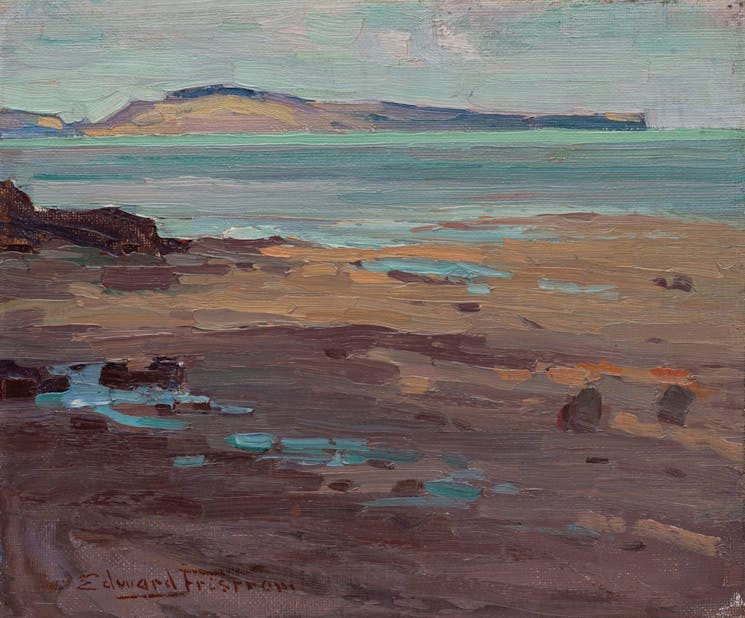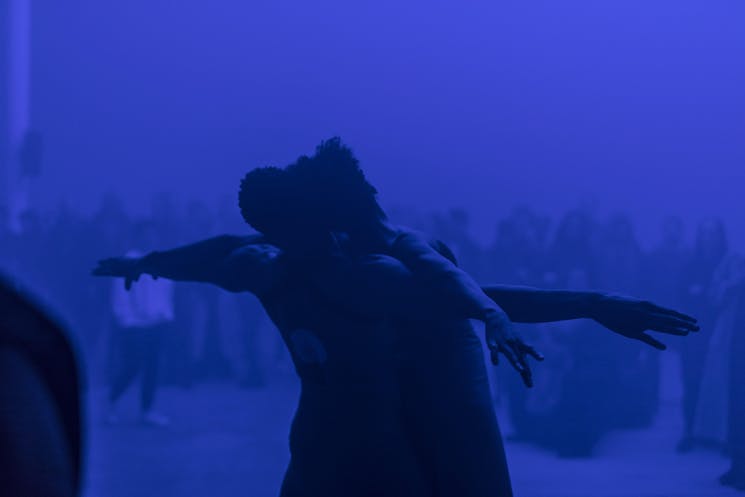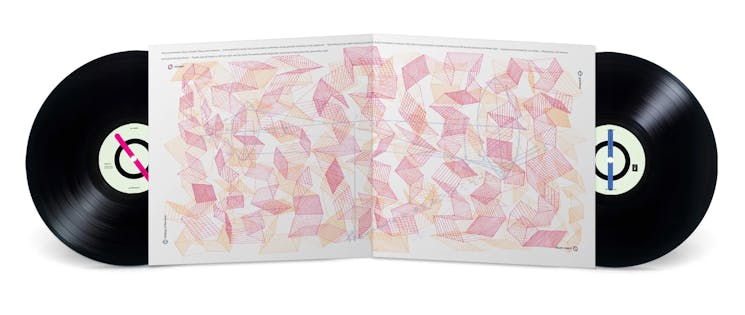Performative Geographies, which brings together a New Zealand and a Chinese artist, argues for strong correlations between historical Western and historical Chinese representations and cultural uses of islands. To understand ‘islandness’ in the cultural imagination both artists produce performative geographies beginning with the assumption that the meaning of islands is not so much apprehended as produced through painting and the construction of images. This is an approach to thinking about islands that refuses to conceive of their meaning as fixed or stable, and attests to the cross-cultural lure of the island for the human imagination.
John Reynolds takes a myth of the origin of Rangitoto, the island that dominates Aucklanders’ daily imaginations, and reproduces it from above as if dropped by a giant hand, but also as an early colonial coastal profile. He has turned for further inspiration to Austrian geologist Ferdinand von Hochstetter who completed geological surveys of Auckland and its volcanoes in 1858-9. Hochstetter produced a remarkable map which, as Sarah Treadwell has remarked, “depicts the astonishing base condition of the city as recurringly volcanic with fiery, unpredictable eruptions that cause both devastation and, later abundant productivity.” Like Hochstetter in his map, Reynolds weaves a complex “relationship between skin and ground, ground and body”, above and below, tones of sandstone and lines of contour and lava. He punctuates his double-view of Rangitoto with small “dots of volcanic activity”, the small signs of the fire and ash of his work’s title.
Islands have long played an important role in the Chinese worldview and narratives of islands go back over two millennia, to the very earliest extant Chinese literature. In Ancient and Imperial China, islands were associated with sacred or heavenly realms, abodes of gods and spirits, and the possibility of immortality. This tradition interacted with Taoist and emergent Buddhist traditions as well, and fed into palace garden landscape architecture, which sought to imitate sacred island landscapes and spatialities. Jin Jiangbo has turned to the myth of Penglai and its representation in the Mogao Caves at Dunhuang in Gansu Province which contain some of the finest examples of Buddhist art spanning a period of a thousand years. He has researched the techniques of the Dunhuang painted murals, where many of the early figures used painting techniques which originated in India, and where shading was applied to achieve a three-dimensional effect. This shading technique is unique to Dunhuang in this period as shading on faces was generally not found in Chinese painting until much later deriving from the influence of European painting. The Dunhuang murals were also notable for their use of silver and gold leaf. In Cave 61 there is a panoramic wall painting of Mount Wutai, the sacred Buddhist site in Shanxi Province, “bathed in golden light and transformed into a Buddhist paradise outside the boundaries of time and space” which, with its depicted temples and divine sites, represents “a synthesis of geography and iconography.” Among its five terraces, which signify the spiritual journey to be traversed, the southern terrace makes reference to the legendary island of Penglai. A manuscript poem by Xuanben found in another nearby cave “notes the cosmic qualities of the Southern Terrace by comparing it to Penglai, the legendary isle of the transcendents in the Eastern Sea.”
Opening Hours
- Tuesday - Friday 11am - 6pm, Saturday 11am - 3pm or by appointment
Address
- 510 Karangahape Road
- Auckland 1010
Performative Geographies, which brings together a New Zealand and a Chinese artist, argues for strong correlations between historical Western and historical Chinese representations and cultural uses of islands. To understand ‘islandness’ in the cultural imagination both artists produce performative geographies beginning with the assumption that the meaning of islands is not so much apprehended as produced through painting and the construction of images. This is an approach to thinking about islands that refuses to conceive of their meaning as fixed or stable, and attests to the cross-cultural lure of the island for the human imagination.
John Reynolds takes a myth of the origin of Rangitoto, the island that dominates Aucklanders’ daily imaginations, and reproduces it from above as if dropped by a giant hand, but also as an early colonial coastal profile. He has turned for further inspiration to Austrian geologist Ferdinand von Hochstetter who completed geological surveys of Auckland and its volcanoes in 1858-9. Hochstetter produced a remarkable map which, as Sarah Treadwell has remarked, “depicts the astonishing base condition of the city as recurringly volcanic with fiery, unpredictable eruptions that cause both devastation and, later abundant productivity.” Like Hochstetter in his map, Reynolds weaves a complex “relationship between skin and ground, ground and body”, above and below, tones of sandstone and lines of contour and lava. He punctuates his double-view of Rangitoto with small “dots of volcanic activity”, the small signs of the fire and ash of his work’s title.
Islands have long played an important role in the Chinese worldview and narratives of islands go back over two millennia, to the very earliest extant Chinese literature. In Ancient and Imperial China, islands were associated with sacred or heavenly realms, abodes of gods and spirits, and the possibility of immortality. This tradition interacted with Taoist and emergent Buddhist traditions as well, and fed into palace garden landscape architecture, which sought to imitate sacred island landscapes and spatialities. Jin Jiangbo has turned to the myth of Penglai and its representation in the Mogao Caves at Dunhuang in Gansu Province which contain some of the finest examples of Buddhist art spanning a period of a thousand years. He has researched the techniques of the Dunhuang painted murals, where many of the early figures used painting techniques which originated in India, and where shading was applied to achieve a three-dimensional effect. This shading technique is unique to Dunhuang in this period as shading on faces was generally not found in Chinese painting until much later deriving from the influence of European painting. The Dunhuang murals were also notable for their use of silver and gold leaf. In Cave 61 there is a panoramic wall painting of Mount Wutai, the sacred Buddhist site in Shanxi Province, “bathed in golden light and transformed into a Buddhist paradise outside the boundaries of time and space” which, with its depicted temples and divine sites, represents “a synthesis of geography and iconography.” Among its five terraces, which signify the spiritual journey to be traversed, the southern terrace makes reference to the legendary island of Penglai. A manuscript poem by Xuanben found in another nearby cave “notes the cosmic qualities of the Southern Terrace by comparing it to Penglai, the legendary isle of the transcendents in the Eastern Sea.”


